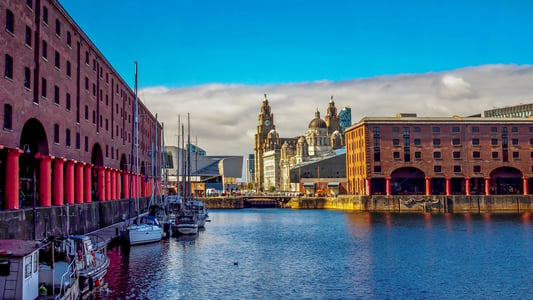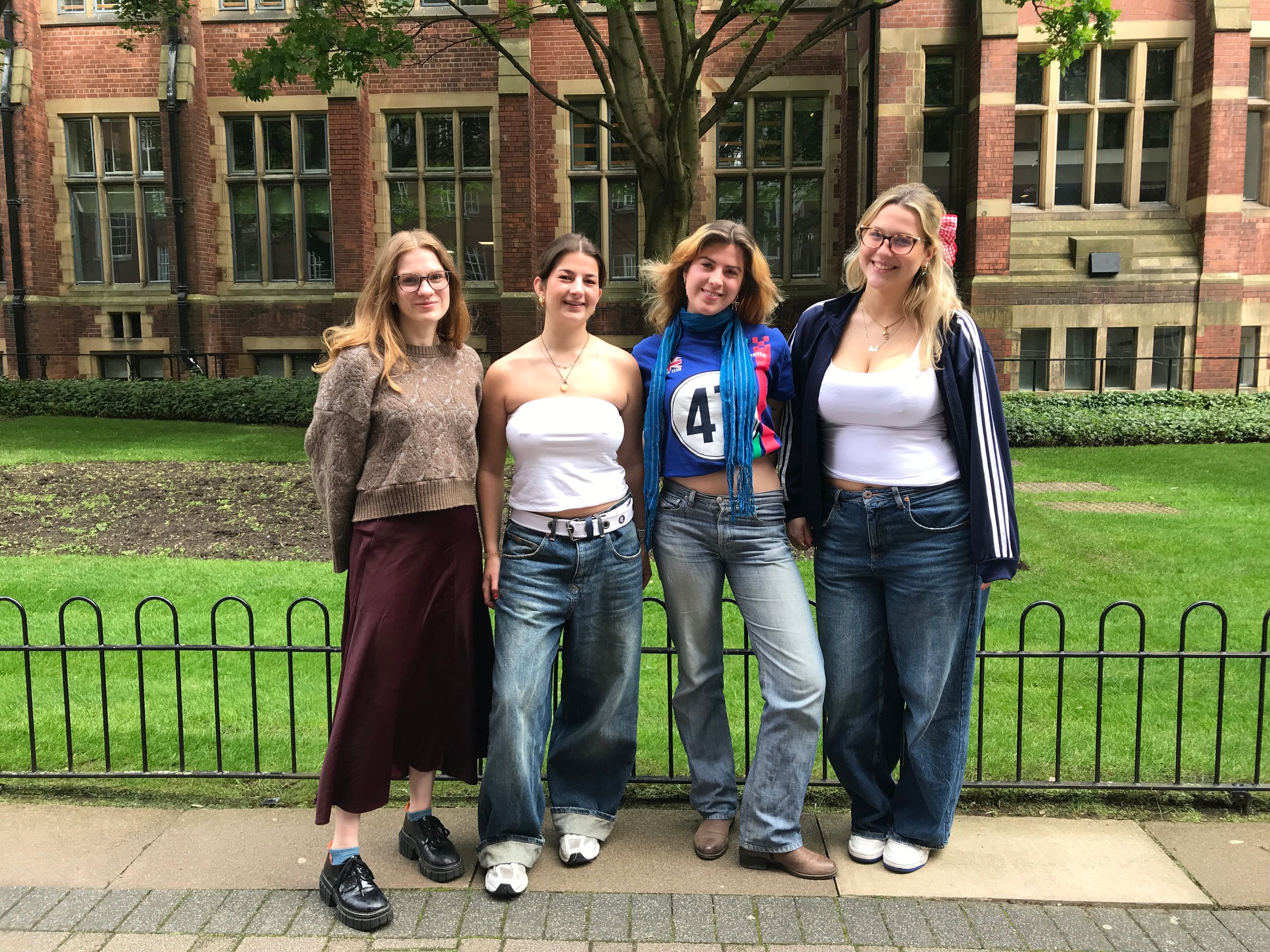Emilia Francis – BA Liberal Arts, University of Leeds – May 2024

The Resonant Rhythm of Liverpool
The transformational power of music was on full display when Liverpool hosted Eurovision 2023 on behalf of Ukraine. Liverpool embodied a warm and open attitude towards others, as a Ukrainian Institute interviewee told, and Eurovision lovers even “showed improvement in wellbeing from pre- to post-Eurovision.”
Liverpool’s inclusive music scene underlines the city’s willingness to be an agent for social change. Simultaneously, it exemplifies Liverpool’s strong orientation on its longstanding musical legacy. Liverpool became a UNESCO City of Music in 2015, recognising its multi-faceted music history and the vitality of the scene today. Music is an inextricable part of its economic, social, and cultural life; its many festivals and music education opportunities mark a solid commitment to encouraging new genres as a reflection of the city’s diversity. So, how are the city’s notorious musical spirit, and its underpinning social purpose, connected?
I think there is a strong connection to be found here. Music can foster positive mental health outcomes in young people, contributing to the achievement of the United Nations’ Sustainable Development Goals (SDGs).
Recently, the role of culture in SDG localisation worldwide has been questioned – and in our Horizons Institute blog on UK UNESCO Cities of Culture, my research group and I added to this strain of questioning. This blog delves into this deeper, by exploring how culture in Liverpool contributes to Target 3.4 – the promotion of mental health and well-being subsumed under SDG 3.
I interviewed professionals acting as agents for social change through culture in Liverpool. Their intersectoral perspectives range from global to local, whether that’s Liverpool’s music strategy as a city, or its communities. Recognising that there is no concerted UK-wide plan to instrumentalise culture for a sustainable future, I was curious to explore what the social impact of music is in Liverpool today.
The City of Music label
My first conversation on the UNESCO City of Music label was with David Connor, founder of 2030hub, the first UN-recognised Local2030 Hub for city-centred reporting on SDG progress. According to Connor, most people in Liverpool do not know that it is a City of Music. The relevance of the UNESCO designated label is not thoroughly understood locally.
As with any other city or community, sustainability efforts need to feel Liverpool-centred to be locally relevant. Connor explained that music as a part of culture amplifies an important message; Liverpool and the diverse communities living within it, are part of a global community working to achieve the SDGs. On the ground, culture is not just an inspiring addition to policy change or leadership statements, but a necessary mechanism to make the ethos of the 2030 Agenda pervasive.
Accordingly, Kevin McManus from Culture Liverpool, part of Liverpool City Council, underscores the prescriptive, locally detached element of the SDGs. McManus, who led on the city’s bid to become UNESCO City of Music, underlines that the strategy driving music as an agent for social change is about the encouragement of city-wide participation in making and experiencing music. However, the label does help Liverpool forge connections internationally, with like-minded actors, for example.
An inside look – Liverpool’s SDG groundwork
Music initiatives for child mental health in Liverpool
The case of Liverpool evidences an impressive range of initiatives using music to improve child mental health locally, supporting the bottom-up implementation of SDG 3 in Liverpool’s own unique way. It is great to see that, as McManus mentions, Liverpool’s public sector is not over relied on to get such purpose-driven projects off the ground. According to Connor, it is not helpful to reiterate the lack of city council funding for meaningful SDG localisation in Liverpool. He emphasises the sentiment that allowed the 2030hub to be created; principally, it is powerful, locally adapted concepts, rather than funding, that allow us to build meaningful solutions. This “doer” culture is even reflected in large-scale events such as Eurovision 2023; Liverpool succeeds at making a social impact through music, because of its people-centric and location-focused approach.
McManus explains what defines those solutions that work best locally. Rather than running for a couple years, as has been typical in the city’s deprived communities, successful projects are long-lived. This is because local trust is invaluable – and we only need to look at the programme In Harmony Liverpool to see why. As a child-focussed scheme for ensemble music-playing, In Harmony started in West Everton in 2009 with the coming together of community mothers, youth club staff, and school staff from Faith Primary School.
Everton is reportedly one of the most deprived areas in Liverpool, and amongst the 10% most disadvantaged areas in the UK. In 2019, over 4 in 10 children participating in the programme lived in poverty. As per Labour councillor Jane Corbett’s comments on West Everton, consistency crucially prevented the project from ending up in “a corner” of the community. The impact of interconnecting culture with child mental health was becoming tangible and visible. As former Culture Secretary Karen Bradley notes:
“…treating the personal, individual benefits to a 12-year-old girl from learning the piano as wholly distinct from the overall benefit to society of music is a false dichotomy. For it is precisely the aggregate effect of these individual experiences that will bring about a healthier, smarter, more peaceable, more cohesive, and happier society.”
Corbett adds that by “making our children very strong and powerful in themselves”, programmes like In Harmony also have a monetary impact. In Harmony’s early-on investment in children has increased education attainment, correlating with less welfare benefit claim. What’s more, the reported improvement in family cohesion decreases the potential cost of future family breakdown. SDG 3, evidently, is interconnected with SDG 8 (decent work and economic growth). McManus describes an additional positive consequence, mentioning the music venue Future Yard in Birkenhead. Young people are trained in the technical sound and light skills deployed at music venues, boosting their employability. This investment not only regenerates the town surrounding such venues… It is also part and parcel of the Liverpool City Council and Liverpool City Region Combined Authority aim to grow the music industry by fostering inclusivity.
As McManus writes, this means staying close to an inclusive image of who makes music (far from being dominated by the Beatles’ legacy, the scene is buzzing with the likes of folk, jazz, classical music and more), and who music is for. For McManus, these initiatives send a message: access to music is for people from any background or community in the city.
In Harmony and child mental health
Since In Harmony’s inception, remarkable youth mental health outcomes have emerged from the structural bedrock of longevity, trust, and emphasis on participation. Not only has it grown youth enjoyment of music, and musicianship itself – but the initiative has enhanced children’s life prospects through their emotional and social wellbeing. Music in practice enhances creativity, confidence, motivation, independence and resilience. Children develop higher aspirations and a positive outlook on the future. Socially, children have evidenced improvement in collaboration, cooperation, teamwork and leading, and enhanced communication abilities involved in friend making, listening, networking and supporting others.
In conversation with Michael Galbraith, a clinical psychologist and family therapist who reported on In Harmony Liverpool’s impact, I explored what is behind these outcomes. Part of In Harmony’s success is that children are offered (sometimes, beneficially, from a very young age) a pathway into music not normally available to them, in a universal, health promotive way. Music in this context is a non-verbal and arguably deeper form of expression.
In Harmony also took caution not to react to a “problem” – but rather, to foster pride in being from Everton. Mental wellbeing, after all, is highly dependent on prevention, maybe even more than intervention. Affirming that “we are a strong community, we are worth something” to Everton’s youth, has noticeably boosted their confidence – and it’s evident from their performances. Music has also become a normal component of the communal and familial day-to-day (“We are all musicians now…”).
For Galbraith, this is attributable to a “leap of imagination” between musical and child development professionals. Rather than controlling outcomes from a singular perspective, it pays off to integrate clinical, family-oriented expertise into the design of music-based programmes for children – precisely because these disciplines are traditionally separate. I believe this leap of faith between actors is equally as necessary between stakeholder groups working towards the SDGs.
There are also limitations. Our continued knowledge on longer-term child mental health outcomes of such music-making, depends on at least 10 years, if not a whole lifespan, of measurement. While there is also cross-sectional research to be done on the impacts for children with different socio-economic backgrounds, Galbraith expects similar positive results for children of all, but especially disadvantaged, backgrounds. Additional barriers to operating within an education framework, as In Harmony does, include national education standards. As Galbraith underlines, UK education is very target focussed, and underplays the value of culture. Lastly, removing financial barriers can expand the role of culture. Musicians involved brought up the need to enlarge capacity, so that they could improve teaching delivery.
Looking ahead – child mental health and music in Liverpool
So, what is the role of local culture in contributing to SDG 3.4, and what could it be in the future?
Firstly, we can conclude that the connections between child mental health in Liverpool, and the UNESCO City of Music label, are under-researched. Centring participation in culture is crucial to contribute positively to the mental life of children. Engagement with culture must be active, and mental health approaches should build on inclusion and self-development, rather than a “problem-view”.
Engagement in classical music, and equally, culture, is not a “quick win”. As Michael Eakin, Chief Executive of the Liverpool Philharmonic stated, “you can’t just go in, do a couple of years and get out again”. Galbraith envisions the expansion of the In Harmony model, by scaling it to dance, drama and the visual arts, for example. Liverpool and other cities could promote family hubs and children’s centres to mainstream engagement with the arts in a broader sense. I am excited to see how more adapted, community-based suggestions like this will emerge in our work to positively impact the mental life of children and advance the SDG-led journey to improve human well-being.
Acknowledgements
Many thanks to David Connor, Kevin McManus and Michael Galbraith for supporting this research with their time and insights.
Exploring Sustainable Development in UK UNESCO Designated Sites

This series of blogs, a continuation from the initial publication by the Horizons Institute at the University of Leeds, has been authored by four second-year BA Liberal Arts students as part of the project ‘Exploring Sustainable Development in UK UNESCO Designated Sites’, for the module ‘FOAH2001: Research Placement’ at the University of Leeds. The project was supervised by Dr Francesca Giliberto, a research fellow specialising in management, cultural heritage, and sustainable (urban) development at the Leeds University Business School, and is developed in partnership with the UK National Commission (UKNC) for UNESCO.
Over the past eight months, these students have explored culturally based sustainable development frameworks within specific UNESCO designated sites across the UK. Their investigation has focused on understanding how these sites navigate interconnected challenges and function as a bridge for local-to-global initiatives. Throughout their research journey, the students have actively engaged with site managers, practitioners, project evaluators, the UKNC for UNESCO, and various stakeholders. Their aim has been to discern the intricate interplay between diverse sectors and objectives, with a particular focus on the practical localisation of the United Nations’ Sustainable Development Goals (SDGs) through the lens of cultural preservation and promotion.

